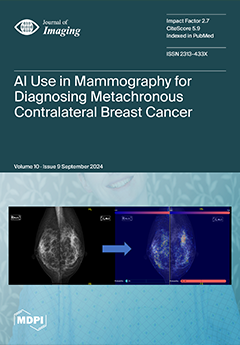Open AccessArticle
AI Use in Mammography for Diagnosing Metachronous Contralateral Breast Cancer
by
Mio Adachi, Tomoyuki Fujioka, Toshiyuki Ishiba, Miyako Nara, Sakiko Maruya, Kumiko Hayashi, Yuichi Kumaki, Emi Yamaga, Leona Katsuta, Du Hao, Mikael Hartman, Feng Mengling, Goshi Oda, Kazunori Kubota and Ukihide Tateishi
Viewed by 860
Abstract
Although several studies have been conducted on artificial intelligence (AI) use in mammography (MG), there is still a paucity of research on the diagnosis of metachronous bilateral breast cancer (BC), which is typically more challenging to diagnose. This study aimed to determine whether
[...] Read more.
Although several studies have been conducted on artificial intelligence (AI) use in mammography (MG), there is still a paucity of research on the diagnosis of metachronous bilateral breast cancer (BC), which is typically more challenging to diagnose. This study aimed to determine whether AI could enhance BC detection, achieving earlier or more accurate diagnoses than radiologists in cases of metachronous contralateral BC. We included patients who underwent unilateral BC surgery and subsequently developed contralateral BC. This retrospective study evaluated the AI-supported MG diagnostic system called FxMammo™. We evaluated the capability of FxMammo™ (FathomX Pte Ltd., Singapore) to diagnose BC more accurately or earlier than radiologists’ assessments. This evaluation was supplemented by reviewing MG readings made by radiologists. Out of 1101 patients who underwent surgery, 10 who had initially undergone a partial mastectomy and later developed contralateral BC were analyzed. The AI system identified malignancies in six cases (60%), while radiologists identified five cases (50%). Notably, two cases (20%) were diagnosed solely by the AI system. Additionally, for these cases, the AI system had identified malignancies a year before the conventional diagnosis. This study highlights the AI system’s effectiveness in diagnosing metachronous contralateral BC via MG. In some cases, the AI system consistently diagnosed cancer earlier than radiological assessments.
Full article
►▼
Show Figures






